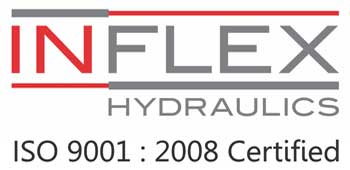Hydraulic Hose with fitting.
Hydraulic fitting types.
The following types of hydraulic fitting types are used widely world-wide :
ORFS: The flat face of ORFS (O-Ring Face Seal) fittings has an O-ring groove. The flat face of the female connection and the O-ring are connected to create a seal for such fittings. These fittings offer a leak-free connection and are perfect for high-pressure applications.
The following types of ORFS fittings are used:
ORFS straight fitting-Male ORFS connection point on a straight screw connected to male NPT, G, or metric threads.
ORFS elbow fitting-Elbow screw connection with a perpendicular ORFS male connector and an ORFS female connection.
Tee-ORFS fitting-One female ORFS connection port and two male ORFS connection ports make up a tee-shaped ORFS fitting.
Cross ORFS- Consists of four cross-oriented male ORFS connection ports, good for combining or distributing media. Accessories like plugs, end caps, and O-rings are frequently used with these ORFS fittings.
BSP/DIN-In Europe, the hydraulic fitting types DIN (Deutsches Institut für Normung) and BSP (British Standard Pipe) are frequently used. In the industrial, construction, oil, and bag industries, DIN fittings ensure interchangeability with various brands of fittings. BSP specifications for screw threads are followed by BSP fittings. They work by locking together external (male) and interior (female) threads and are used to seal and connect pipes. Except for North America, where NPT standards are used, they are mostly utilised in the plumbing industry and are universally accepted.
Common hydraulic fluids
The hydraulic oil or fluid in the system is sealed, using hydraulic fittings. As a result, the fittings need to be compatible with the fluid being utilised. The energy needed by the system for the machinery to operate is provided by hydraulic fluid. The market is filled with various varieties of hydraulic media.
Petroleum-based fluids: The most common hydraulic fluid is mineral- or petroleum-based. These fluids’ additives offer defence against corrosion, wear and tear, rust, and severe pressure.
Water-based fluids-These fluids are utilised for fire resistance because of their high water content. They come in water-in-oil, oil-in-water, and water-glycol emulsion varieties.
Synthetic Fluids : These man-made substances have benefits including lesser friction, fire resistance, and thermal stability. They have exceptional lubricating properties, making them perfect for use in high-temperature and high-pressure applications. They usually cost more than petroleum-based fluids.
Selection criteria for fittings
When choosing the appropriate hydraulic fitting types for your application, the following factors should be considered:
Size: The fittings’ internal and external diameters are two crucial sizes to take into account. These fitting diameters ought to match the diameter of the hose. Fittings that are too big or too small can leak or break the connection.
Material: The hydraulic fitting’s material should be suitable for both the operating environment and the hydraulic fluid. Brass, aluminium, steel, or stainless steel are the fitting materials that are utilised the most frequently.
Temperature: The hydraulic fittings need to work in your range of temperatures.
Pressure: The hydraulic fittings, including the pressure spikes, must be appropriate for your pressure range. Operating outside of this range can result in damage to the fittings.
Application: The type of application also determines the fitting type to be used. Tee- or cross- fittings are used for mixing or distribution application.
Assembly: Hydraulic quick-connect fittings can be utilised if the hydraulic system necessitates frequent hose or tube connection and disconnecting. Similar to soldering or welding, hydraulic compression fittings can be utilised to eliminate the requirement for the fitting. It creates a very tight seal by compressing against the ferrule using a compression nut. It can be utilised in hot environments because welded seams can leak in those conditions.
How to properly connect to a hydraulic hose with a hydraulic fitting:
- Make sure the hose is the appropriate length. In order to lower the possibility of contamination and assembly problems, hose cutters can be used to cut it to the ideal size with clean ends.
- Make the proper hydraulic hose fitting selection. Ascertain that the fitting’s size, pressure, temperature, material, style, and orientation are appropriate for your operation.
- Choose the fitting’s insertion depth before marking the hose with a marker. Insert the hose into the fitting until it reaches the mark on the hose after applying lubricant, if necessary.
- Place the hose end in the crimping machine, set the crimper to the proper diameter, and then crimp the hose.
- Check the diameter of the crimp.
- Clean the hose properly to prevent contamination. using a hose brush.
Common Applications
- Hydraulic fittings are used for piping and tubing with hydraulic hoses in the following applications:
- Assembly lines, presses, robotics, and hydraulic power units are examples of industrial applications.
- Equipment used in mining and construction
- Agricultural machinery
- Applications for plumbing
- the oil and gas sector
- Chemical Industry
Should you need new hydraulic hose assembly or replace an existing hose, call Inflex Hydraulics on +971 4 339 4677, for comprehensive solutions.
Hydraulic Hose with fitting.
